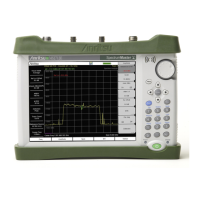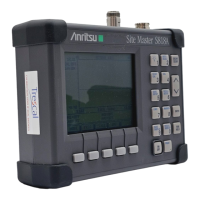Chapter 2 — Spectrum Analyzer Verification 2-6 Input Related Spurious (IRS) Signals Verification
MS2720T MM PN: 10580-00342 Rev. D 2-11
55. Press the Shift key and then press the Trace (5) key. Press the Trace A Operations submenu key.
56. Press the # of Averages submenu key, use the keypad to enter 5, and then press the Enter key.
57. Wait until the Trace Count displays 5/5.
58. Press the Marker main menu key and press the Peak Search submenu key.
59. Record the amplitude at 8000 MHz into the “Measured Spur Level” column of Table A-6, “Measured
Input Signal Level at 8000 MHz” on page A-3.
60. Press the Freq key and press the Start Freq submenu key.
61. Use the keypad to enter 7719, and press the MHz submenu key.
62. Press Stop Freq submenu key, enter 7721, and press the MHz submenu key.
63. Press the Shift key and then press the Trace (5) key. Press the Trace A Operations submenu key.
64. Press the # of Averages submenu key, use the keypad to enter 5, and then press the Enter key.
65. Wait until the Trace Count displays 5/5.
66. Press the Marker main menu key and press the Peak Search submenu key.
67. Record the Marker 1 amplitude reading into the “Measured Spur Level” column of Table A-6.
68. Calculate the input related spurious level by subtracting the Marker 1 reading in Step 59 from the
Marker 1 reading in Step 67. Record the result into the “Calculated IRS” column of Table A-6.
69. Verify that the calculated result is ≤ –60 dBc.
15000 MHz Input Related Spurious Check (for MS2720T with option 720, 732 or 743 only):
70. Set the MG3692x or MG3695C output to
15000 MHz, with an RF output level of –30 dBm.
71. Press the Freq key and press the Center Freq submenu key.
72. Use the keypad to enter 15000, and press the MHz submenu key.
73. Press the Shift key and then press the Trace (5) key. Press the Trace A Operations submenu key.
74. Press the # of Averages submenu key, use the keypad to enter 5, and then press the Enter key.
75. Wait until the Trace Count displays 5/5.
76. Press the Marker main menu key and press the Peak Search submenu key.
77. Record the amplitude at 15000 MHz into the “Measured Spur Level” column of Table A-7, “Measured
Input Signal Level at 15000 MHz” on page A-3.
78. Press the Freq key and press the Start Freq submenu key.
79. Use the keypad to enter 14719, and press the MHz submenu key.
80. Press Stop Freq submenu key, enter 14721, and press the MHz submenu key.
81. Press the Shift key and then press the Trace (5) key. Press the Trace A Operations submenu key.
82. Press the # of Averages submenu key, use the keypad to enter 5, and then press the Enter key.
83. Wait until the Trace Count displays 5/5.
84. Press the Marker main menu key and press the Peak Search submenu key.
85. Record the Marker 1 amplitude reading into the “Measured Spur Level” column of Table A-7.
86. Calculate the input related spurious level by subtracting the Marker 1 reading in Step 77
from the
Marker 1 reading in Step 85. Record the result into the “Calculated IRS” column of Table A-7.
87. Verify that the calculated result is ≤ –60 dBc.

